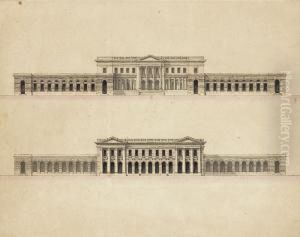Marie Joseph Peyre Paintings
Marie Joseph Peyre, who is often known under his formal name, Marie-Joseph Peyre, was a French architect who made significant contributions to the neoclassical movement in France during the 18th century. Born on July 25, 1730, in Paris, Peyre was trained under the prominent French architect Jacques-François Blondel and quickly rose to prominence within the French architectural scene. His career was marked by his successful integration of classical architectural principles with the emerging neoclassical aesthetics of his time.
Peyre won the prestigious Prix de Rome in 1751, which was an award given to promising young artists and architects that granted them the opportunity to study at the French Academy in Rome. His time in Rome had a profound influence on his architectural style, as he was exposed to the works of ancient Greek and Roman architecture as well as the Renaissance and Baroque movements. Peyre's experiences in Italy helped to solidify his commitment to the neoclassical style, which was characterized by its emphasis on simplicity, symmetry, and harmony.
Upon his return to France, Peyre collaborated with another Prix de Rome laureate, Charles De Wailly, on a number of projects. One of their most famous works is the Théâtre de l'Odéon in Paris, which exemplified their neoclassical approach. The theater’s design incorporates a clear and structured layout with a restrained ornamentation that reflects the ideals of clarity and rationality.
Peyre was also known for his theoretical work on architecture. He published a number of influential texts, including 'Oeuvres d'architecture de M. Peyre l'aîné,' which disseminated his ideas on neoclassicism and contributed to the spread of the movement throughout Europe. His writings and designs were instrumental in the transition from the more decorative Rococo style to the more austere neoclassical style that would dominate the late 18th century and beyond.
Marie Joseph Peyre's career was a testament to the intellectual and cultural shifts of his time. His work and thought process reflected the Age of Enlightenment's values of reason, science, and the re-examination of classical antiquity. Peyre passed away on January 11, 1785, in Paris. His legacy continued to influence architects and the development of neoclassical architecture well into the 19th century.
